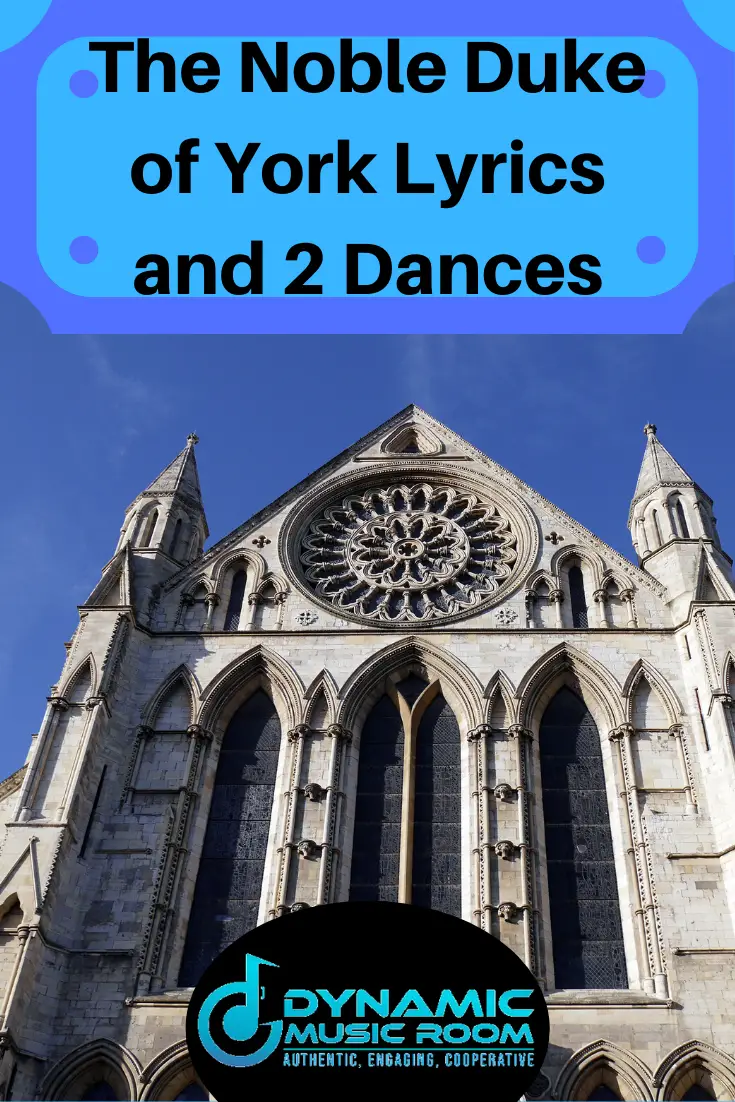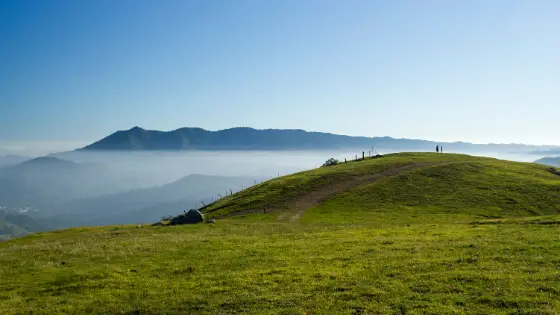Do you want a fun and classic folk song to do with your younger students?
As a child, I remember the show Barney doing this song, and I thought it was fun back then. But when I saw my host teacher playing the song with a dance, I knew it would be a fun part of my music teacher repertoire.
Whichever version of the name you use, let’s dig into the Noble Duke Of York Lyric and dance.
Look ahead for a breakdown of the song, lyrics and variation, and two ways to dance to the tune.
Table of Contents
The Grand Old Duke Of York Song Breakdown
This song is fun to sing and come up with funny rhymes in the B section all the way through 3rd grade. The dances (see below) are simple enough Kindergarten and First grade can do it which is when I usually use this song.
Pitches: low sol, low la, do, re, mi, fa
Rhythms: dotted eighth-sixteenth, dotted quarter note-eighth note, half note, paired eighth note, quarter rest
Form: AB Song
Lyrics:
This is the version I’m most familiar with, but see the dedicated lyrics section below for more variations.
A Section
Oh, the noble Duke of York,
He had 10,000 men.
He marched them up to the top of the hill,
And he marched them down again.
And when they were up, they were up.
And when they were down, they were down.
And when they were only halfway up,
They were neither up nor down.
B Section
Oh, a-hunting we will go.
A-hunting we will go.
We’ll catch a fox and put him in a box,
And then we’ll let him go.
Oh, a-hunting we will go.
A-hunting we will go.
We’ll catch a dog and put him in a log,
And then we’ll let him go.
Note: The last lines of the B section rhyme and change using any animal you or the students wish.
Origin: 1642 English Nursery Rhyme, Roud Folk Song Index #742.
The Noble Duke Of York Lyrics And Variations
There are several variations of the lyrics to this song. The bulk of the lyrics stay the same as written in the previous section.
The biggest difference is in the adjective describing the duke. The version I’m familiar with states he is “noble” while the traditional version states “grand” instead.
The rest of the A section remains the same.
In the earlier versions of the song/nursery rhyme, the B section (a-hunting) is left out completely.
The modern version was published in the early 1900s in Arthur Rackham’s, Mother Goose.
The earliest we know was called the Old Tarlton’s song written down in 1642. This version used the following lyrics:
The King of France with forty thousand men,
Came up a hill and so came down again.
Source: J. Orchard Halliwell-Phillipps and Henry Chettle, eds, Tarlton’s Jests: And News Out of Purgatory (Oxford: Oxford University Press, 1844)
The duke in question has been hotly debated over the centuries. Regardless of the exact duke referenced, the song has been used as satire for public officials with foolish efforts.
Among the Dukes of York throughout history, here are few of the commonly thought sources:
- Richard
- James II
- Prince Frederick
The rhyme went on to combine with the melody of a separate song, A-hunting We Will Go, which is likely where the use of the latter as a B section was born.
There are several instances of the song being adapted by other countries and used to make fun of their own royalty.

The Noble Duke Of York Dance: 2 Ways
The Noble Duke of York is fun to play in dance form. I’ve seen this done several ways, but this section will cover two of my favorites.
These ways were inspired by my host teacher, Paul Rose, from whom I first heard the song in an elementary music setting.
You may also want to check out these best freeze dance songs and how to play guide.
Simple Circle Dance
This version needs all students in a single circle. I usually do this version with my end-of-the year Kindergarten students.
It works well for these kids up to second grade. I usually notice around third grade when the enjoyment of this dance starts to wear off.
In the single circle, everyone faces the middle and does the following moves matching the words.
A Section
- Oh, the noble Duke of York = step in for 4 and clap on 4
- He had 10,000 men = step out for 4 and clap on 4
- He marched them up to the top of the hill, and he marched them down again = Slow turn in place for 7 beats and clap on 8
- And when they were up they were up = in 4, clap on 4
- And when they were down they were down = out 4, clap on 4
- And when they were only halfway up, they were neither up nor down = slow turn in place for 7 beats and clap on 8
B Section
During the whole “a-hunting we will go” part, students turn to the right and follow the leader as they skip around the room.
By the end of the second repetition of the song, the leader needs to lead the class back into the circle.
Repeat as needed with different leaders if desired.
Longways (Two Long Lines) Dance
The longways (or longwise) version of the dance is a little trickier, and I usually save it for first grade. It’s possible to do this in Kindergarten, but there’s no rush and other folk dances for Kindergarten out there.
For this version, students are split into two long lines facing one another. The person across from them is their partner.
When I first teach this, all partners will be in one single line, but as they get more independent, I split them up into sets of 4 partners each.
The moves match the words as follows:
A Section:
- Oh, the noble Duke of York = in 4, clap partners hands on 4
- He had 10,000 men = out 4, clap own hands on 4
- He marched them up to the top of the hill, and he marched them down again = right arm swing for 7 beats one time and back to spot to clap on 8
- And when they were up, they were up = in 4, clap partners hands on 4
- And when they were down, they were down = out 4, clap own hands on 4
- And when they were only halfway up, they were neither up nor down = right arm swing for 7 beats one time and back to spot to clap on 8
B Section:
Every 8 beats the partners at the top of the set (front of the lines) take hands and sashay down the bottom of the set and join the lines. With 2 repetitions of the B section, you’ll send down 4 partners.
People in the lines clap their hands while the other sashay down the set.
I love this version because it provides a simple way to practice key folk dance moves like right arm swings and sashays.
Conclusion
I hope you enjoyed learning a little more about the Noble Duke of York lyrics, dance, and how to use it in your classroom. I love this song, and I bet your students will too!
Check out our list of 17 folk songs every kid should know.

